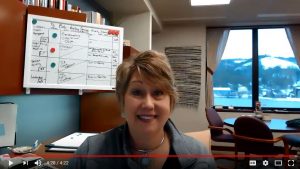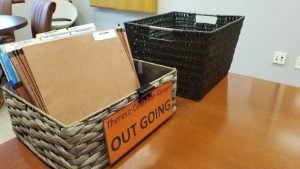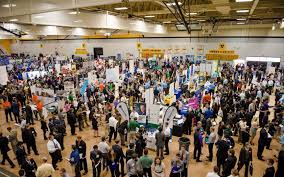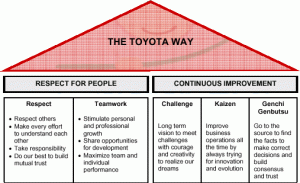There has been a new Kaizen started here in the Office of Continuous Improvement, and I get to be the PIC for it! The new Kaizen is through the JR Van Pelt and Opie Library. The topic will be based around the scheduling methods of conference room 103 in the Library. Chad Arney, Director of Strategic Initiatives, is the team leader. He has proven to be very knowledgeable, both in the understanding of Library itself and in Google calendar. Andrew Miles (Financial Aid Manager), Briana Tucker (Student Engagement Coordinator), and Lori Weir (Dir Admin Services & Projects) are the three facilitators that have volunteered for this Kaizen. An added bonus, is that they are all outside eyes, and often ask very formidable questions about the process for how to schedule the conference room. Our team members are Annelise Doll and Mia Kemppainen, both employees in the library who know the process inside and out, and work with it on a daily basis.
We held our pre-meeting at the beginning of the March and identified what the problem was exactly. Chad explained the confusion and difficulty there was just to reserve the conference room, which believe me, was very confusing, especially for an outsider looking in. It was a bit unbelievable to see the process that people have to go through to reserve this room. Not only is there a lengthy process, but there is all the potential for other people to be in the room or that another reservation could be made, over-booking your event.
We held our first Kaizen day this past Monday with the whole team together in one room. We were able to create a process map of what people have to do to reserve the room. We were also able to figure out some things in Google calendar that really none of us have really known about before, like knowing who can reserve the room on campus and how Google calendar can accept whether or not the room can be reserved. It was very interesting to learn about these new things I hadn’t known before. We were also able to identify the different things that people struggle with when reserving the room.
Overall, it’s been, and hopefully will continue to be a fun, exciting, and great learning experience.
I was recently presented with an opportunity to “think Lean” outside of my normal work setting, with others who are unfamiliar with Lean. I have found that in a work place where Lean is the norm, it is very easy to do things the Lean way, especially since everyone is working towards Continuous Improvement. The real challenge is to implement Lean in areas of your life that you hadn’t normally before, and to challenge the way you previously reacted to situations. One of my personal challenges has been to remember to “Blame the process” when there’s an issue, instead of blaming myself or another. Instead, you must look at the process in order to find the areas that create opportunity for mistakes and waste.
Our student organization MEDLIFE had a shipment come in for a fundraiser, in which we looked at the master sheet to make sure we had everything we were supposed to, which we did. Off to a good start, we started distributing the goods. It wasn’t until we came to the last few orders that we realized we were short multiple packages, and customers orders were missing items. After wracking our brains and consulting, we found out that an entire order hadn’t been ordered, as the order sheet was in an envelope that was thought to contain only money, and it was never opened.
In situations like this, I have time and again looked for the person to blame, the person who “screwed up”. It was what I had been used to, and was something I used to witness on a daily basis. However, before I could let this take hold of me, I took a deep breath and chanted to myself “Blame the process, not the person.” And so, after figuring out how it was corrected, we all congregated and began the break-down of the issue.
We used 5 Whys to understand what lead to the envelope and order being missed, which led us to understand that the overall collection process had been terribly messy and un-standardized. People had randomly dropped off orders, names were not on all the papers, some money was in envelopes, some money was just clipped together, and most of it was not labeled. In addition, if we had taken the time to separate orders before allowing people to pick them up, we could have caught the issue sooner and there wouldn’t have been multiple incomplete orders.
Overall, a recipe for disaster! After going through everything, I was astounded by the fact that only one order had been missed, as it must have been very frustrating for those who had the job of counting everything up and recording the orders. With this information, we now have a standard of how things are to be labeled and turned in, as well as by whom and when. This way, our collection process for any future fundraiser will be much more efficient, and less stressful for those who are collecting.
Not only did it feel good that I was able to react in a Lean way, but it was also a good experience to correct an issue the Lean way with others.
Yesterday I attended the Michigan Tech Career Fair. I wasn’t going in-order to get a job, internship, co-op, or anything really, except for experience. Not many companies are looking for anyone like me with my major being Sports and Fitness Management, and me being a first year, the odds that I would get offered anything by any company were very slim, if at all in existence. Just to clarify, no, I was not offered a job or internship, but I did gain a bit of experience and confidence from career fair as a whole.
Last semester at career fair, I just walked around and didn’t really do too much, but this time I was determined to at least talk with one company to gain some sort of experience. I first went and got my name tag, had my professional picture taken (because I really needed one of those, living without one on my LinkedIn has been killing me!) So, after that was out of the way, I grabbed a map of the Multi-Purpose Room, and a list of all the companies that were represented. Like I said, I wasn’t looking for anything but experience, so I wasn’t searching for any company in particular.
I walked in and did a couple of laps just to see what companies were there, and I noticed one that didn’t have anyone at it, so after A LOT of hesitation I finally just walked up and said hello. I talked with the representatives from the Oakland Road Commission, and essentially just told them that I wasn’t looking for anything like a job offer or anything, and I just told them a little about myself. During this conversation I brought up my talking point, Lean and CI, which was my common subject with any company that was represented at the career fair. Both representatives knew about Lean and we had a nice conversation about what I do with it here at Michigan Tech, and they told me about a couple processes in their company that have been modified using Lean tactics. After our conversation came to a close, I thanked them, and moved on.
I talked with a couple other companies, neither of which knew about Lean or CI, so it was a very valuable teaching moment for myself, and maybe I might hopefully have been a spark for their companies to get invested in Lean. I told them about the Office of Continuous Improvement here at Michigan Tech, and just what my job is here in the Office of Continuous Improvement. I also tried my best to explain exactly what Lean is, but everyone has a different definition for Lean, so I tried my hardest and I told them about some Kaizens that I’m working on and the processes that are involved to get them to their end states.
Overall, I had a pretty good time at career fair, especially after I got over my fear of talking to strangers. I’m excited for next year’s career fairs, to hopefully get some more experience, and to possibly spread the word of Lean further!
From a young age we were taught to obey our elders, use our manners, and present ourselves in an appropriate manner. As we got older, more detail was added. Saying “please” and “thank you” wasn’t enough, we also had to treat others how we wanted to be treated, be kind, and help others when they needed it. Everyday, we add a little more detail to all of these areas, we learn a little bit more. What am I describing? Have you caught yourself saying it in your head? If you need to, reread this paragraph slower, then continue on.
Did you catch it now? I’m describing respect. Respect is the foundation to every relationship we have. Whether it be with a spouse, a co-worker, a boss, a friend. The amount of relationships we have, are endless. Respect fuels these relationships and if the respect is lost, then often times so is the relationship (unless you actively try to rebuild it).
Because respect is such a fundamental piece of human nature, I believe this is why Toyota made “Respect” one of it’s two pillars (the other being Continuous Improvement). This pillar is referred to as “Respect for People.” We’ve talked plenty before about respect for people, so instead I want to talk about how “Respect for People,” may have been a false translation when it was translated from Japanese to English.
I’ve been doing lots of digging lately and I found some pieces written by a man named Jon Miller who summarized that the Japanese phrase, ningensei no soncho (人間性の尊重) was once translated, resulting in the phrase: “Respect for people.” After further translation it was found that the phrase was actually meant to be, “Respect for Humanity,” or “Respect for Human Nature.”
Before I totally throw you off, respect for humanity does indeed include respect for people, but “respect for people” simply doesn’t bring justice to the entirety of Toyota’s pillar. Some parts were lost in translation. When respect for humanity is broken down, it results in three areas: Respect for the workers, Respect for the customers and suppliers, and respect for the environment. All areas that human interaction is involved while producing, or consuming a product.
Respect is a huge part of Lean, and that’s because it’s a huge part of life. Respect goes beyond our interactions between other humans, it involves our relationship with our products, ourselves, our homes, our world. Creating honest emotion, passion, and empowerment. Without respect, lean would fail, just like everything else does. Respect for people is important, but when we expand our respect beyond people, greater things are produced.
Citations:
“Respect For Humanity.” Lean manufacturing – Practical advice, information resourcesand, 2014, www.lean-manufacturing-junction.com/respect-for-humanity.html.
Miller, Jon. “Respect for humanity…of your boss.” Gemba Academy, 10 Aug. 2015, blog.gembaacademy.com/2015/08/10/respect-for-humanity-of-your-boss/.
Here in the Office of Continuous Improvement, we are always striving to continuously improve in all of our activities. Recently, we were introduced to another opportunity to grow through a new practice (to us) called Incremental Improvement.
Most often, our work consists of large massive sweeps of improvement, tackling large projects and issues with Kaizens. This calls for the scheduling large increments of time around multiple busy schedules. Daily office work usually includes dedicating chunks of time to a project until it’s complete, before moving on to the next project on the agenda.
Incremental Improvement focuses on smaller solutions and actions when tackling large projects, and allows for completion through small steps and not leaps and bounds. It allows for easier implementation of ideas, which meets less resistance as any changes are slowly made and adjusted to. Changes implemented are less risky, and allows for PDCA on a smaller scale. Overall, the improvements made are done by the staff collectively, as they all have the knowledge and power to implement more beneficial improvements.
Right now, the Office of Continuous Improvement is working on a Lean Lending Library project, where we’re making a standardized activity check-out. This would allow anyone to come in and check-out a learning activity and have all the information and materials they would need in order to do the activity. We could see right away that it definitely would be a large project, but were ready to get down to business!
At first, we wanted to just start tackling it head on, and initially figured someone would be assigned to work on the project with it as a priority. However, after being introduced to the concept of Incremental Improvement, we began looking at how we could break the monster project into smaller steps instead. Now we’re steadily going through each step, bit by bit. Small amounts of time are consistently made for us to work on the steps of the project, in comparison to someone working on it for large chunks of time when they’re able to.
Already, the progress we have made is tangible, though there is still a lot more work to do. I personally have found that this large project is not so daunting now that it has been broken up, and is continuously being worked on bit by bit. I’m very excited to see the end results of our Incremental Improvements!
Fellow PIC’s Rylie Store, Ari Laiho, and myself embarked on a journey to try to improve the Ripley Kids program at Mont Ripley. Rylie is the Ripley Kids Program Coordinator, so she essentially runs the show when it comes to the Ripley Kids program. Ari is an instructor in the program, a ski and snowboard enthusiast herself. I, however, don’t ski or snowboard, and have honestly never even heard of the Ripley Kids program, so this was a whole new experience from day one for me.
Rylie was the team leader on this Kaizen, Ari facilitated it, and I was introduced to my first Kaizen as a PIC. Rylie, Ari, and I had our pre-meeting, and Rylie explained a lot of the challenges, difficulties, and frustrations she has to face as the Program Coordinator. She was worrying about instructors not showing up, classes not starting or ending on time, keeping track of each group, and the registration process (just to name a few). Needless to say, it was time for some improvements.
Rylie and Ari compiled a team that is directly involved with the Ripley Kids process, and they addressed many of the same issues Rylie shared in the pre-meeting. So, we went to work. The team was able to come up with many great ideas that the team was able to incorporate into the Ripley Kids program. They held an instructors meeting, where Rylie talked with all the instructors, and got their input on what they’d like to see in the Ripley Kids program, which went very successfully.
We just had our two month check-in yesterday, for a check-in on how things are going. Rylie said that this has been probably one of, if not the most successful years of Ripley Kids yet. They were able to purchase helmet covers to help in keeping track of each group as well as each kid in the groups, and so far there haven’t been any issues and non-of the covers have gone mission because Rylie has built a system for keeping track of them after each lesson. There was some resistance to the changes, simply because the processes are new, but overall the instructors seem to be enjoying the program more, and seem to be more committed to Ripley Kids, which has made everything else go much smoother. Rylie has also been keeping track of metrics such as start times, questions asks, the amount of time instructors spend on each lesson.
One of the biggest things Rylie has implemented is a reflection process after each lesson. Each instructor fills out a reflection to track the progress of each kid in their group, it helps to show the instructors and Rylie to see the progress and plan the next lesson plan in a way that is tailored to each student.
I am very lucky to be a part of this Kaizen, and I’m glad seeing that everything things improved, I can’t wait to see what the future holds for the Ripley Kids program.
Lean spends a great amount of time emphasizing the importance of the People. Whether this be through mutual respect, humility, Systems thinking, equality among ranks, Coaching, Teamwork, Active Listening, Conflict management… the list truly goes on and on. This is exactly why Toyota made “Respect for people” as one of two pillars supporting their foundation.
The other pillar is Continuous Improvement. As Jeff Liker illustrates in his book The Toyota Way, Continuous Improvement is an embodiment of three areas:
- Challenge – A long term vision that is designed to tackle challenges in a creative and valiant way that shows us what our goals are.
- Kaizen – Constant improvement in the operations of a business through change and adaptation.
- Genchi Genbutsu – “Go to the source to find the facts to make correct decisions and build consensus and trust.”
Continuous Improvement is not just a two word title. It is a change in mindset. It’s a sense of purpose, to strive for something greater and actually achieve it. Here at Michigan Tech we really emphasize this pillar. I mean, we are the Office of Continuous Improvement. We focus on utilizing the people we have, and their bodies of knowledge to propel the university higher. Our model of Continuous Improvement circulates around learning to improve, and we do this by:
- Going to the Gemba – where work is done
- Collecting metrics
- Implementing the Scientific Method – Kata, PDCA, A3
- Understanding the customers point of view so that we can add value
- and Practicing a no blame environment – It’s the process not the people
The goal of our office at Michigan Tech is to help all areas of campus to reduce waste, and add value so that the University can function at the optimum level and focus on our customers, the students. We could not implement this second pillar of lean, if it weren’t for the first, the people. The people at this university, lean practitioners or non, are what drives our campus up.
The people here at Michigan Tech are almost always willing to join forces and tackle waste so that we can continuously improve and thrive.
We are pleased to post this guest blog by Theresa Coleman-Kaiser, Senior Associate Vice President for Administration at Michigan Technological University.
I have been practicing online coaching using Lean principles and Kata concepts during short, frequent meetings for nearly six months. I started with finding my own coach who then guided me to begin and improve this practice. I now have six coachees that I am guiding to strengthen their own success and to improve Michigan Tech.
The coaching sessions were going really well, but they lacked any Visual Management element which is an important Lean tool that makes work visible. My coach encouraged me to figure out a way to incorporate Visual Management into my online coaching sessions. I created a video to explain how I used rapid experimentation through several PDCA cycles to implement Visual Management.
You can watch the video here: https://youtu.be/gEbf1aQTkMQ
I hope you enjoy learning from my experience. Do you have an effective way of using Visual Management using an online platform?

We are pleased to present this guest blog by Brenda Randell, Executive Assistant at Michigan Technological University.
Are you running from meeting to meeting, feeling overwhelmed and un-prepared? Theresa Coleman-Kaiser, Senior Associate Vice President for Administration, has been there and has since implemented a system to help overcome those obstacles. The system continues to improve, but I would like to share how we currently manage events in order to keep her feeling calm and prepared throughout the day.
The system depends heavily on the Google Calendar, Brenda, and Theresa herself. It also depends on the folders and our filing system that we have in place. Most value-adding elements that Theresa needs to do is scheduled on her calendar, leaving 3:00 – 5:00 p.m. “available” for emails and follow-up from the day’s meetings. Things often come up throughout the day and she uses this time to catch-up.
Theresa’s calendar is very detailed, with standards set. There is a standard 30-minute prep for every meeting, which is scheduled two days in advance (allowing for the possibility of needing to reschedule that time.) If Theresa gets ahead of schedule, she moves on to the next item. Travel-time is booked on the calendar as well. Color-coding occurs, but is done very cautiously because colors start to become meaningless when you use too many. Theresa uses four different colors, with red signaling “do not schedule”. Work-time is scheduled on the calendar with each block including additional details such as date of request, the number and the number of occurrences (i.e. 1 of 1), amount of time specified, and the due date. I am starting to include this with Theresa’s meetings that she requests, and I find it to be especially helpful for me if I need to reschedule that particular meeting.
Theresa is responsible for informing me what is needed and everything she needs is noted and put into my box. She is also in tune with the system so if I am not here, she is able to continue working through her day(s) without difficulty.
Folders used throughout the day are filed according to a previously developed standard. That standard color-codes sections (departments). For example: Human Resource-related items are placed in a green folder. Each folder has a standard label with the font, size, and information. The example below shows the folder title as “compensation strategy task force” and the sub-title explains the location of the file. Filed under “employment” in “Human Resources”. Having this standard makes it easy to file as well as find the file.
Theresa’s work flow circulates. I easily pull the folder that relates to the calendar item and set it up in a parallel sequence to her calendar. Theresa pulls the folder and takes care of the calendar item. She then writes notes of additional requests for that particular calendar item and puts the folder into my box. I then take the folders out of my box multiple times per day and do one, or multiple, of the following tasks: complete/finalize agenda, email and print agendas/attachments, schedule work time, schedule meeting, file the folder, and/or place folder in the pile for the next day that it will be needed.
What tips can you share to add flow to your work day?
Sample label – this particular label would be placed on a green file folder.
COMPENSATION STRATEGY TASK FORCE
(Human Resources – Employment)


Just after the semester started, I completed PIC training, and one of the first things I was assigned to as a PIC was to take over the MUB basement Kaizen from Matt, since he left the office. I was kind of terrified of it at first because it’d be technically my first Kaizen on my own, and I didn’t really have very much of an idea of what Kaizen’s really were yet, so I’m sure you can tell why I was a bit scared of it.
I started working with the team on the Kaizen at a newspaper meeting since the Kaizen technically started in January of 2017, so the processes at the beginning of the Kaizen were already long gone. Anyway, the first newspaper meeting I went to, we did a Gemba Walk through the basement and there was still some standards to be set with the janitorial supplies/carts, fire safety was another thing that still had to be implemented, and some small clutter things were waiting to be moved out. The next newspaper meeting, during our Gemba Walk, everything was moved/implemented, and there wasn’t very much left to do in the Kaizen itself. However, the two sides (Dining & Auxiliary Services/MUB) that have control of the MUB Basement decided to split up to assign uses for their parts of the basement.
Going through some of the pictures of the basement prior to the Kaizen, it’s so unbelievable seeing the changes that have been made, going from not have very much if ANY space to even walk, to having rooms opened and things having their own place, it’s a transformation unlike any other. Also the team has been fortunate enough to learn a lot of safety and disposal laws during the Kaizen. Even during the closure meeting during reflections, the only thing that the team could really say was “WOW.”
Now the two teams are doing their own Kaizens on their portions of the MUB Basement to see what to do with their areas, what processes work best for them, and what they’re trying to achieve. I’m very excited to see what will happen in the future given the tremendous transformation already. Both teams are just past the pre-meeting stage, and are moving on to the Kaizen days, so I can’t wait to see what’ll happen.



